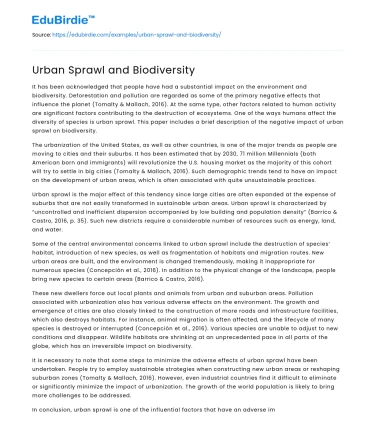It has been acknowledged that people have had a substantial impact on the environment and biodiversity. Deforestation and pollution are regarded as some of the primary negative effects that influence the planet (Tomalty & Mallach, 2016). At the same type, other factors related to human activity are significant factors contributing to the destruction of ecosystems. One of the ways humans affect the diversity of species is urban sprawl. This paper includes a brief description of the negative impact of urban sprawl on biodiversity.
The urbanization of the United States, as well as other countries, is one of the major trends as people are moving to cities and their suburbs. It has been estimated that by 2030, 71 million Millennials (both American born and immigrants) will revolutionize the U.S. housing market as the majority of this cohort will try to settle in big cities (Tomalty & Mallach, 2016). Such demographic trends tend to have an impact on the development of urban areas, which is often associated with quite unsustainable practices.
Save your time!
We can take care of your essay
- Proper editing and formatting
- Free revision, title page, and bibliography
- Flexible prices and money-back guarantee
Urban sprawl is the major effect of this tendency since large cities are often expanded at the expense of suburbs that are not easily transformed in sustainable urban areas. Urban sprawl is characterized by “uncontrolled and inefficient dispersion accompanied by low building and population density” (Barrico & Castro, 2016, p. 35). Such new districts require a considerable number of resources such as energy, land, and water.
Some of the central environmental concerns linked to urban sprawl include the destruction of species’ habitat, introduction of new species, as well as fragmentation of habitats and migration routes. New urban areas are built, and the environment is changed tremendously, making it inappropriate for numerous species (Concepción et al., 2016). In addition to the physical change of the landscape, people bring new species to certain areas (Barrico & Castro, 2016).
These new dwellers force out local plants and animals from urban and suburban areas. Pollution associated with urbanization also has various adverse effects on the environment. The growth and emergence of cities are also closely linked to the construction of more roads and infrastructure facilities, which also destroys habitats. For instance, animal migration is often affected, and the lifecycle of many species is destroyed or interrupted (Concepción et al., 2016). Various species are unable to adjust to new conditions and disappear. Wildlife habitats are shrinking at an unprecedented pace in all parts of the globe, which has an irreversible impact on biodiversity.
It is necessary to note that some steps to minimize the adverse effects of urban sprawl have been undertaken. People try to employ sustainable strategies when constructing new urban areas or reshaping suburban zones (Tomalty & Mallach, 2016). However, even industrial countries find it difficult to eliminate or significantly minimize the impact of urbanization. The growth of the world population is likely to bring more challenges to be addressed.
In conclusion, urban sprawl is one of the influential factors that have an adverse impact on biodiversity. People’s irresponsible use of natural resources (primarily land) leads to the destruction of habitats forcing numerous species out of their habitats. Some species try to adapt to new habitats, but many fail to do so, and biodiversity in many areas is in danger. Although some countries and communities try to minimize their footprint on the environment, these measures are far from being sufficient, as numerous species disappear each year.






 Stuck on your essay?
Stuck on your essay?

